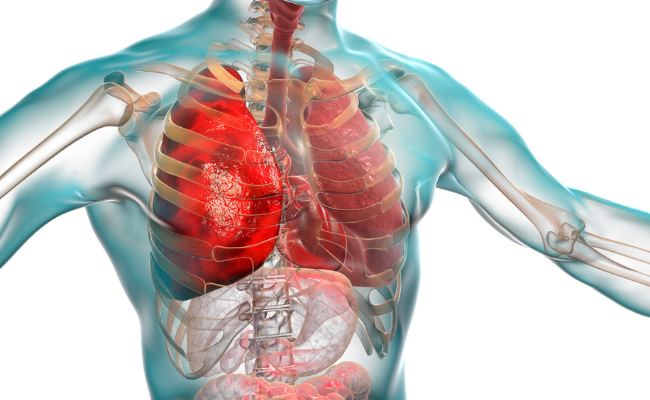How to Treat Aspiration Pneumonia?
- January 18, 2024
- No Comments

What is Aspiration Pneumonia?
Aspiration pneumonia arises when foreign substances, typically originating from the mouth or stomach, are unintentionally breathed into the lungs, resulting in a lung infection. This material encompasses a range of elements, such as food, liquids, saliva, or vomited contents. The condition poses a significant threat, especially for individuals with compromised immune systems, underlying health conditions, or difficulties in swallowing. It's important to distinguish aspiration pneumonia from aspiration pneumonitis, a condition where a similar inhalation of non-air substances occurs, leading to inflammation and irritation without an actual infection. Differentiating between these two conditions can be challenging due to their similar presentations.
Aspiration pneumonia is also known by other names, including anaerobic pneumonia, necrotizing pneumonia, and aspiration of vomitus. These terms are used interchangeably to describe instances where substances other than air are aspirated into the respiratory tract, potentially causing respiratory complications.
Why Does Aspiration Pneumonia Occur?
Aspiration pneumonia typically arises when protective reflexes, such as coughing and the gag reflex, fail to prevent the entry of foreign material into the respiratory tract. Several factors can contribute to the development of aspiration pneumonia, including neurological disorders that affect swallowing (such as stroke or Parkinson's disease), impaired consciousness (due to alcohol or drug use, anesthesia, or medical conditions), and conditions that weaken the immune system.
How is Aspiration Pneumonia Diagnosed?
Diagnosing aspiration pneumonia involves a thorough medical evaluation, including a review of the individual's medical history, physical examination, and imaging studies. Chest X-rays are commonly used to identify infiltrates or abnormalities in the lungs. Additionally, blood tests may be conducted to assess the severity of the infection and identify the causative organism.
Treatment Solutions for Aspiration Pneumonia:
- Antibiotics: Antibiotics are a fundamental component of treating aspiration pneumonia. The choice of antibiotic depends on the suspected or identified causative organism. Aspiration pneumonia is often caused by bacteria present in the mouth or stomach. Antibiotics help eliminate the infection and prevent its spread within the lungs. The selection of antibiotics is based on the severity of the infection, the individual's overall health, and any underlying medical conditions. Intravenous antibiotics may be administered in severe cases, while oral antibiotics are suitable for milder cases. Timely administration of appropriate antibiotics is crucial for effectively treating aspiration pneumonia, preventing complications, and promoting recovery.
- Supportive Care: Supportive care involves measures to alleviate symptoms and provide assistance to individuals with aspiration pneumonia. Supportive care aims to enhance the individual's comfort, manage respiratory distress, and promote overall well-being during the recovery process. Oxygen therapy may be administered to improve oxygen levels in the blood. In severe cases, mechanical ventilation might be necessary. Hydration and nutrition support are essential, especially if swallowing is compromised. Supportive care addresses the immediate needs of individuals with aspiration pneumonia, ensuring optimal conditions for recovery and minimizing complications.
- Treatment of Underlying Conditions: Addressing the underlying conditions that contributed to aspiration is crucial in preventing recurrence. Neurological disorders, impaired consciousness, or conditions affecting swallowing increase the risk of aspiration. Treating these underlying issues helps prevent future incidents of aspiration pneumonia. Treatment may involve physical therapy to improve swallowing function, medication adjustments, or management of chronic conditions contributing to aspiration risk. By addressing the root causes of aspiration, healthcare providers can work towards preventing future occurrences and improving the overall health of the individual.
- Rehabilitation Services: Rehabilitation services, including speech therapy and physical therapy, play a vital role in the recovery process. Aspiration pneumonia can be associated with impaired swallowing and physical weakness. Rehabilitation services aim to restore functional abilities and reduce the risk of complications. Speech therapy focuses on improving swallowing techniques, while physical therapy addresses weakness and mobility issues. These interventions contribute to a comprehensive recovery plan. Rehabilitation services enhance the individual's functional capacity, facilitating a faster and more complete recovery from aspiration pneumonia.
Benefits of Seeking Treatment for Aspiration Pneumonia
- Prevention of Complications: Timely and appropriate treatment reduces the risk of complications associated with aspiration pneumonia, such as respiratory failure, sepsis, or lung abscesses.
- Improved Respiratory Function: Treatment, including antibiotics and supportive care, helps clear the infection and restore normal respiratory function. This contributes to improved oxygenation and alleviates breathing difficulties.
- Enhanced Quality of Life: Addressing underlying conditions and providing rehabilitation services contribute to an improved quality of life for individuals recovering from aspiration pneumonia. Rehabilitation services help restore independence and functionality.
- Reduced Risk of Recurrence: Treating underlying conditions and implementing preventive measures, such as speech therapy, reduces the likelihood of future episodes of aspiration pneumonia.
- Comprehensive Recovery: The combination of medical treatment, supportive care, and rehabilitation services ensures a more comprehensive and effective recovery process, minimizing the impact of aspiration pneumonia on overall health.
Comments (0)